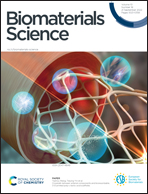Tumor-penetrating iron oxide nanoclusters for T1/T2 dual mode MR imaging-guided combination therapy†
Abstract
Emerging nanotheranostic systems have promoted the development of dual-mode imaging techniques (i.e. T1/T2-weighted MRI) to meet the increasing requirements of accurate personalized treatment for cancer. Nevertheless, slight tumor accumulation and poor penetration have limited the efficacy of dual-mode theranostic agents. Furthermore, under the premise of guaranteeing imaging capability, most current research studies hardly focused on optimizing theranostic agents to achieve considerable therapeutic effects. Here, we developed a hyaluronic acid (HA)-stabilized iron oxide nanocluster (Fe2O3@PFDH NC) as an intelligent-degradable theranostic nanoagent for dual-mode MRI-guided chemo-photothermal therapy. The obtained Fe2O3@PFDH NC with high longitudinal and transverse relaxivities offers strong contrast in T1/T2-weighted MR imaging. Meanwhile, according to MR images, the intravenous Fe2O3@PFDH NC could accumulate at the hyaluronidase-rich tumor location gradually. More interestingly, it could break into smaller nanoparticles with quick DOX release for deep penetration, accompanied by highly effective photothermal ablation of the tumor under laser irradiation. In conclusion, the versatile tumor-penetrating Fe2O3@PFDH nanocluster could serve as a T1/T2 dual-mode MRI contrast agent with highly effective combination chemo-photothermal therapy, and would be an ideal theranostic nanocarrier with translational potential for future clinical diagnosis and treatment of cancer.



 Please wait while we load your content...
Please wait while we load your content...